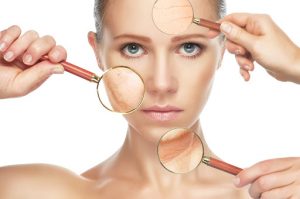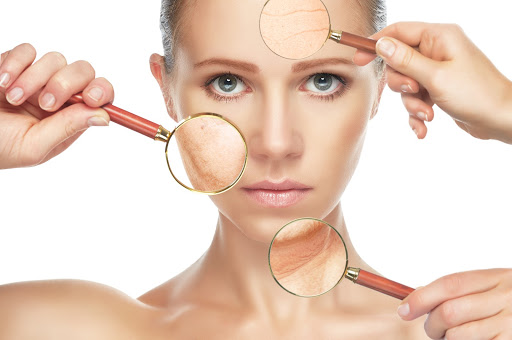

Evidence has shown that those suffering from facial skin conditions are at a disadvantage when it comes to getting hired, determining income, and ultimately what opportunities are available to them.
Many facial skin conditions can be detrimental to self-esteem, interpersonal behavior, as well as potentially reflective of an underlying health issue.
The following facial skin conditions are common, however, understanding the causes, symptoms, and treatments can help you determine the next course of action.
1. Acne
Acne is the most common skin condition in the United States. Around 50 million Americans — from adolescents to adults — have experienced acne. This skin condition occurs when hair follicles are blocked due to oil and dead skin cells. Acne can crop up at any age and for anyone.
- Causes: Hormones, medications, diet, and stress can contribute to excessive oil production, bacteria, and inflammation of the skin on the face, back, and chest. When hair follicles become blocked, it can create a variety of symptoms.
- Symptoms: Acne can show up in the form of whiteheads, blackheads, pimples, small red bumps on the skin, larger masses developing under the skin, and pus-filled cysts under the skin.
- Treatments: Depending on the severity, acne can be treated in several ways. Antibiotics may reduce skin bacteria and inflammation. Over-the-counter and prescription drugs that contain retinoic, azelaic, and salicylic acids can also help combat bacteria and prevent clogged hair follicles. Oral medications, topical creams, and treatments such as chemical peels and steroid injections may all be used to treat acne before scarring and permanent dark spots occur.
2. Contact Dermatitis
Those with sensitive skin may commonly experience dermatitis. When your skin comes into contact with an irritant or allergen, it can cause several uncomfortable and skin reactions.
- Causes: Contact dermatitis can be caused by an allergen, irritant, or a combination of both. Irritants such as rubbing alcohol, bleach, certain shampoos and soaps, plants, fertilizers, and pesticides can cause contact dermatitis. Additionally, allergens such as particular metals, medications, poison ivy, and even sunscreens can create contact dermatitis. For instance, if you are allergic to certain metals, a watch band made out of nickel can cause a contact dermatitis flare-up.
- Symptoms: Contact dermatitis can show up as a red rash, itching, blisters, and dry, cracked skin.
- Treatments: Contact dermatitis can be minimized by knowing and avoiding irritants and allergens, washing your skin of these substances, creating barriers between irritants and allergens and your skin, and using facial skin moisturizers. It is also a good idea to be cautious of pets, as irritants and allergens can hide on pet fur and come into contact with your skin.
3. Eczema
There is no cure for atopic dermatitis, or eczema, but treatment and medication can alleviate the symptoms. Eczema generally affects children but may occur at any age.
- Causes: Eczema occurs when your skin is unable to produce and maintain the level of moisture it needs to shield you from environmental factors such as irritants, allergens, and bacteria. It may also be caused by food allergies. You will likely experience eczema if you have a family history of this skin condition.
- Symptoms: Eczema can cause dry skin (leading to cracked, scaly skin), itching, red and brown patches, and raw and swollen skin (from scratching). Symptoms can last a while, flaring sporadically and then clearing up for years sometimes. Eczema may also lead to asthma and hay fever in certain instances.
- Treatments: You can reduce the symptoms of eczema by avoiding irritants, shorter bathing times while avoiding hot water, taking a bleach bath, and moisturizing your skin regularly.
4. Hives
Urticaria, or hives, can have several causes. Depending on the cause, hives will show in different iterations. Acute urticaria, chronic urticaria and angioedema, physical urticaria, and dermatographism are all different types of hives that last anywhere from a few minutes to several months. 20% of people may contract hives during their lifetime.
- Causes: When your body has an allergic reaction, it releases histamine which may accumulate in the skin and cause skin issues. Hives can be caused by certain medications, food allergies (such as a nut allergy), pet dander, insect bites, plants, sunlight, extreme temperature, and even exercise.
- Symptoms: Hives can prompt red blotches of skin, skin welts of various shapes and sizes, rashes swelling, and itching.
- Treatments: Since histamines are the root problem for hives, antihistamines are often recommended to treat the symptoms. Hives that stick around for a longer time may require antibiotics, injections, acupuncture, and/or seeing an allergist, immunologist, or dermatologist.
5. Hyperpigmentation
Hyperpigmentation refers to dark spots that can show up on your skin that may only cover a small portion of your entire body. There are three common types of hyperpigmentation including melasma, sunspots (liver spots), and post-inflammatory hyperpigmentation.
- Causes: Melanin — the pigment that determines skin color — can become overproduced due to several factors, causing dark spots to show up on your skin. Hyperpigmentation can be caused by certain medications, hormone changes, and excessive sun exposure. Injuries or wounds, such as scars from acne, can cause hyperpigmentation as well.
- Symptoms: Hyperpigmentation will appear as a darkened spot (darker than the skin surrounding it), or patches of skin anywhere on your body.
- Treatments: There are many hyperpigmentation treatments, including lightening creams, acid and chemical peels, laser peels, retinoids, microdermabrasion, and more depending on the severity.
6. Melasma
Melasma is another skin pigmentation disorder and most commonly appears on the face but can emerge on the forearms, neck, and shoulders. This skin disorder produces brown and/or grey patches on your skin. It is not fully understood how melasma develops, however, there are a few things that can trigger this skin condition.
- Causes: Melasma has been associated with hormone changes (especially during pregnancy), birth control pills, sun exposure, and particular skincare products that may irritate your skin.
- Symptoms: Melasma affects your pigmentation and produces dark spots to certain areas of your skin. You may be more likely to develop melasma if you have darker skin, as it has more pigment-producing cells.
- Treatments: Although the root cause is not fully known, there are several treatments to lessen melasma, including limiting your sun exposure and wearing sunscreen, medication and topical treatments, practicing good hygiene, introducing antioxidants into your diet, and using moisturizer and melasma creams.
7. Milia
Milia can happen to anyone — but it is most notably found in infants. It is typically not painful or itchy. This condition generates tiny white bumps, mostly in the facial area.
- Causes: When keratin (a protein of skin tissue, hair, and nails) becomes trapped under your skin, it can take the form of tiny white bumps anywhere, but you’ll likely see milia around the eyelids and cheeks.
- Symptoms: You may not notice milia because it is itchy or produces a red spot or rash, but rather just by looking in the mirror and seeing several white dots on your skin.
- Treatments: There are several types of milia including neonatal and juvenile milia, milia en plaque, multiple eruptive milia, milia associated with medication, and traumatic milia. Aside from neonatal milia (which generally needs no treatment), you have several treatment options. Cryotherapy, deroofing, topical creams, chemical peels, laser therapy, diathermy, and destruction curettage are all methods to treat milia.
8. Psoriasis
This skin disorder creates red, bumpy blotches that are covered with scaly white dead skin cells. This happens because psoriasis causes your skin cells to multiply 10 times faster than average. The skin piles up into these red patches on your knees and elbows, scalp, lower back, and hands and feet. About 8 million Americans are ailed with psoriasis.
- Causes: The cause of psoriasis is unknown, however, it is believed to be a defect of the immune system causing inflammation, and producing new skin cells to form more rapidly than normal. There are several triggers associated with psoriasis including cuts and scrapes, stress, infections, and medications such as blood pressure beta-blockers and antimalarial medication.
- Symptoms: Generally, psoriasis produces red patches topped with white/silvery scaly plaques. The affected skin can itch, or painfully crack and bleed. Additionally, there are four types of psoriasis including pustular, guttate, inverse, and erythrodermic. These types may show up on different areas of the skin, may bring about other health conditions, and may be more painful than others.
- Treatments: Psoriasis has no cure, but can be treated to minimize its symptoms. Face moisturizing creams, steroids, and retinoid creams are all common topical treatments for psoriasis. Proper exfoliation techniques and products can help combat this skin condition as well.
9. Rosacea
Rosacea is a chronic inflammatory condition that affects roughly 14 million people, most commonly between the ages of 30 and 50. Rosacea mainly affects the face and eyes. Females are most commonly affected by this skin condition, however, anyone over the age of 30, smokers, and lighter-skinned people may experience it as well.
- Causes: The cause of rosacea is unknown, but is believed to be the result of hereditary and environmental factors. Things that may trigger rosacea include spicy foods, hot beverages, alcohol, sun and wind exposure, and even a particular skin mite (demodex).
- Symptoms: Those who have rosacea might experience redness in the face, swollen skin, red bumps, dry and swollen eyes, and an enlarged nose. Depending on the type of rosacea you have — erythematotelangiectatic, papulopustular, phymatous, or ocular — you may experience redness and swelling in different areas and will require differing treatments.
- Treatments: There are many treatments to minimize rosacea symptoms including wearing sunscreen, green-tinted makeup, managing your stress and alcohol intake, azelaic acid, creams containing oatmeal, and quitting smoking.
10. Shingles
Shingles are perhaps the most painful skin condition on this list. It can occur anywhere on the body. About one in three Americans will develop shingles, with an estimated 1 million people contracting it every year.
- Causes: Shingles is caused by the varicella-zoster virus, which is the same virus that causes chickenpox. If you’ve had chickenpox, the virus may lay dormant for a while in nerve tissue near the spinal cord, but can resurface as shingles later on. Shingles are contagious and can be transmitted to other people who haven’t had chickenpox or are not vaccinated.
- Symptoms: Shingles can produce red rashes and blistering that can painfully break open. It may also cause a burning or tingling sensation and itching in the affected areas.
- Treatments: To prevent shingles, you may get a shingles vaccine. To manage shingles symptoms, you may use topical creams and medicated lotions, numbing agents, anti-inflammatory medications such as ibuprofen, oatmeal baths, and prescription painkillers.
For most skin conditions, good skin hygiene and skincare regimen is encouraged alongside any prescription and/or treatments recommended by a health professional. Proper skincare can also minimize the unsightly symptoms associated with many adult skin conditions.

